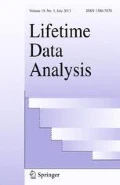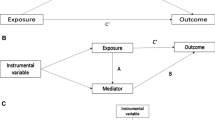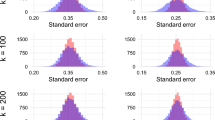Abstract
Joint models with shared Gaussian random effects have been conventionally used in analysis of longitudinal outcome and survival endpoint in biomedical or public health research. However, misspecifying the normality assumption of random effects can lead to serious bias in parameter estimation and future prediction. In this paper, we study joint models of general longitudinal outcomes and survival endpoint but allow the underlying distribution of shared random effect to be completely unknown. For inference, we propose to use a mixture of Gaussian distributions as an approximation to this unknown distribution and adopt an Expectation–Maximization (EM) algorithm for computation. Either AIC and BIC criteria are adopted for selecting the number of mixtures. We demonstrate the proposed method via a number of simulation studies. We illustrate our approach with the data from the Carolina Head and Neck Cancer Study (CHANCE).



Similar content being viewed by others
References
Agresti A, Caffo B, Ohman-Strickland P (2004) Examples in which mis-specification of a random effects distribution reduces efficiency, and possible remedies. Comput Stat Data Anal 47:639–653
Akaike H (1973) Information theory and an extension of the maximum likelihood principle. In: Petrov BN, Csáki F (eds) 2nd international symposium on information theory, Tsahkadsor, Armenia, USSR, September 2–8, 1971. Budapest, Akadémiai Kiad’o, pp 267–281
Albert PS, Follmann DA (2000) Modeling repeated count data subject to informative dropout. Biometrics 56:667–677
Albert PS, Follmann DA (2007) Random effects and latent processes approaches for analyzing binary longitudinal data with missingness: a comparison of approaches using opiate clinical trial data. Stat Methods Med Res 16:417–439
Baghfalaki T, Ganjali M, Verbeke G (2016) A shared parameter model of longitudinal measurements and survival time with heterogeneous random-effects distribution. J Appl Stat. doi:10.1080/02664763.2016.1266309
Böhning D (1999) Computer-assisted analysis of mixtures and applications: meta-analysis, disease mapping and others, number 81 in monographs on statistics and applied probability. Chapman & Hall/CRC, Boca Raton
Brown ER, Ibrahim JG (2003) A bayesian semiparametric joint hierarchical model for longitudinal and survival data. Biometrics 59:221–228
Caffo B, Ming-Wen A, Rohde C (2007) Flexible random intercept models for binary outcomes using mixtures of normals. Comput Stat Data Anal 51:5220–5235
Cagnone S, Viroli C (2012) A factor mixture analysis model for multivariate binary data. Stat Model 12(3):257–277
Chakraborty A, Das K (2010) Inferences for joint modelling of repeated ordinal scores and time to event data. Comput Math Methods Med 11:281–295
Chen W, Ghosh D, Raghunathan TE, Sargent DJ (2009) Bayesian variable selection with joint modeling of categorical and survival outcomes: an application to individualizing chemotherapy treatment in advanced colorectal cancer. Biometrics 65:1030–1040
Chen JH, Kalbfleisch JD (1996) Penalized minimum-distance estimates in finite mixture models. Can J Stat 24:167–175
Chen JH, Kalbfleisch JD (2005) Modified likelihood ratio test in finite mixture models with a structural parameter. J Stat Plan Inference 129:93–107
Cheon K, Albert PS, Zhang ZW (2012) The impact of random-effect misspecification on percentile estimation for longitudinal growth data. Stat Med 31:3708–3718
Choi J, Cai J, Zeng D (2017) Penalized likelihood approach for simultaneous analysis of survival time and binary longitudinal outcome. Sankhya Ser B. doi:10.1007/s13571-017-0132-3
Choi J, Cai J, Zeng D, Olshan AF (2015) Joint analysis of survival time and longitudinal categorical outcomes. Stat Biosci 7:19–47
Cook J, Stefanski LA (1994) Simulation extrapolation estimation in parametric measurement error models. J Am Stat Assoc 89:1314–1328
Ding J, Wang JL (2008) Modeling longitudinal data with nonparametric multiplicative random effects jointly with survival data. Biometrics 64:546–556
Divaris K, Olshan AF, Smith J, Bell ME, Weissler MC, Funkhouser WK, Bradshaw PT (2010) Oral health and risk for head and neck squamous cell carcinoma: the Carolina Head and Neck Cancer Study. Cancer Cause Control 21:567–575
Dunson DB, Herring AH (2005) Bayesian latent variable models for mixed discrete outcomes. Biostatistics 6:11–25
Elashoff RM, Li G, Li N (2007) An approach to joint analysis of longitudinal measurements and competing risks failure time data. Stat Med 26:2813–2835
Elashoff RM, Li G, Li N (2008) A joint model for longitudinal measurements and survival data in the presence of multiple failure types. Biometrics 64:762–771
Fieuws S, Spiessens B, Draney K (2004) Mixture models. In: De Boeck P, Wilson M (eds) Explanatory item response models: a generalized linear and nonlinear approach. Springer, New York, pp 317–340 Ch. 11
Gallant AR, Nychka DW (1987) Seminonparametric maximum likelihood estimation. Econometrica 55:363–390
Garre FG, Zwinderman AH, Geskus RB, Sijpkens YWJ (2008) A joint latent class changepoint model to improve the prediction of time to graft failure. J R Stat Soc Ser A (Stat Soc) 171(1):299–308
Ghosh P, Ghosh K, Tiwari RC (2011) Joint modeling of longitudinal data and informative dropout time in the presence of multiple changepoints. Stat Med 30(6):611–626
Henderson R, Diggle P, Dobson A (2000) Joint modeling of longitudinal measurements and event time data. Biometrics 4:465–480
Heagerty PJ, Kurland BF (2001) Misspecified maximum likelihood estimates and generalised linear mixed models. Biometrika 88:973–985
Hogan J, Laird N (1997) Mixture models for the joint distribution of repeated measures and event times. Stat Med 16:239–257
Hsieh F, Tseng YK, Wang JL (2006) Joint modeling of survival and longitudinal data: likelihood approach revisited. Biometrics 62:1037–1043
Hu W, Li G, Li N (2009) A Bayesian approach to joint analysis of longitudinal measurements and competing risks failure time data. Stat Med 28:1601–1619
Huang X, Li G, Elashfoff RM (2010) A joint model of longitudinal and competing risks survival data with heterogeneous random effects and outlying longitudinal measurements. Stat Interface 3:185–195
Huang X, Li G, Elashfoff RM, Pan J (2011) A general joint model for longitudinal measurements and competing risks survival data with heterogeneous random effects. Lifetime Data Anal 17:80–100
Huang X, Stefanski LA, Davidian M (2006) Latent-model robustness in structural measurement error models. Biometrika 93:53–64
Huang X, Stefanski LA, Davidian M (2009) Latent-model robustness in joint models for a primary endpoint and a longitudinal process. Biometrics 65(3):719–727
Kleinman KP, Ibrahim JG (1998) A semiparametric Bayesian approach to the random effects model. Biometrics 54:921–938
Larsen K (2004) Joint analysis of time-to-event and multiple binary indicators of latent classes. Biometrics 60:85–92
Lemenuel-Diot A, Mallet A, Laveille C, Bruno R (2005) Estimating heterogeneity in random effects models for longitudinal data. Biom J 47:329–345
Lesperance ML, Kalbfleisch JD (1992) An algorithm for computing the nonparametric MLE of a mixing distribution. J Am Stat Assoc 87:120–126
Lin H, McCulloch CE, Turnbull BW, Slate EH, Clark LC (2000) A latent class mixed model for analyzing biomarker trajectories in longitudinal data with irregularly scheduled observations. Stat Med 19:1303–1318
Lin H, Turnbull BW, McCulloch CE, Slate EH (2002) Latent class models for joint analysis of longitudinal biomarker and event process data: application to longitudinal prostate-specific antigen readings and prostate cancer. J Am Stat Assoc 97(457):53–65
Liu L, Ma JZ, O’Quigley J (2008) Joint analysis of multi-level repeated measures data and survival: an application to the end stage renal disease (ESRD) data. Stat Med 27:5676–5691
Liu L, Wolfe RA, Kalbfleisch JD (2007) A shared random effects model for censored medical costs and mortality. Stat Med 26:139–155
Louis TA (1982) Finding the observed information matrix when using the EM algorithm. J R Stat Soc Ser B 44:226–233
Muthén B, Shedden K (1999) Finite mixture modeling with mixture outcome using the EM algorithm. Biometrics 55:463–469
Neuhaus JM, Hauck WW, Kalbfleisch JD (1992) The effects of mixture distribution misspecification when fitting mixed-effects logistic models. Biometrika 79:755–762
Proust-Lima C, Séne M, Taylor JM, Jacqmin-Gadda H (2014) Joint latent class models for longitudinal and time-to-event data: a review. Stat Methods Med Res 23(1):74–90
Rizopoulos D, Verbeke G, Lesaffre E, Vanrenterghem Y (2008) A two-part joint model for the analysis of survival and longitudinal binary data with excess zeros. Biometrics 64:611–619
Rizopoulos D, Verbeke G, Molenberghs G (2008) Shared parameter models under random effects misspecification. Biometrika 95:63–74
Satterthwaite FW (1946) An approximate distribution of estimates of variance components. Biometrics 2:110–114
Schwarz GE (1978) Estimating the dimension of a model. Ann Stat 6(2):461–464
Song X, Davidian M, Tsiatis AA (2002) A semiparametric likelihood approach to joint modeling of longitudinal and time-to-event data. Biometrics 58:742–753
Song X, Wang CY (2007) Semiparametric approaches for joint modeling of longitudinal and survival data with time-varying coefficients. Biometrics 64:557–566
Stefanski LA, Cook J (1995) Simulation extrapolation: the measurement error jackknife. J Am Stat Assoc 90:1247–56
Tseng YK, Hsieh R, Wang JL (2005) Joint modelling of accelerated failure time and longitudinal data. Biometrika 92:587–603
Tsiatis AA, Degruttola V, Wulfsohn M (1995) Modeling the relationship of survival to longitudinal data measured with error. Applications to survival and CD4 counts in patients with AIDS. J Am Stat Assoc 90:27–37
Tsiatis AA, Davidian M (2001) A semiparametric estimator for the proportional hazards model with longitudinal covariates measured with error. Biometrika 88:447–458
Verbeke G, Lesaffre E (1996) A linear mixed-effects model with heterogeneity in the random-effects model with heterogeneity in the random-effects population. J Am Stat Assoc 91:217–221
Verbeke G, Molengerghs G (2000) Linear mixed models for longitudinal data, Springer series in statistics. Springer, New-York
Verbeke G, Molengerghs G (2013) The gradient function as an exploratory goodness-of-fit assessment of the random-effects distribution in mixed models. Biostatistics 14:477–490
Wang Y, Taylor JMG (2001) Jointly modeling longitudinal and event time data with application to acquired immunodeficiency syndrome. J Am Stat Assoc 96:895–905
Wang CY, Wang N, Wang S (2000) Regression analysis when covariates are regression parameters of a random effects model for observed longitudinal measurements. Biometrics 56:487–495
Wu M, Carroll R (1988) Estimation and comparison of changes in the presence of informative right censoring by modelling the censoring process. Biometrics 44:175–188
Wulfsohn M, Tsiatis AA (1997) A joint model for survival and longitudinal data measured with error. Biometrics 53:330–39
Xu W, Hedeker D (2001) A random-effects mixture model for classifying treatment response in longitudinal clinical trials. J Biopharm Stat 11:253–273
Xu J, Zeger S (2001a) The evaluation of multiple surrogate endpoints. Biometrics 57:81–87
Xu J, Zeger S (2001b) Joint analysis of longitudinal data comprising repeated measures and times to events. Appl Stat 50:375–387
Ye W, Lin XH, Taylor JMG (2008) Semiparametric modeling of longitudinal measurements and time-to-event data-a two-stage regression calibration approach. Biometrics 64:1238–1246
Zeng D, Cai J (2005a) Simultaneous modelling of survival and longitudinal data with an application to repeated quality of life measures. Lifetime Data Anal 11:151–174
Zeng D, Cai J (2005b) Asymptotic results for maximum likelihood estimators in joint analysis of repeated measurements and survival time. Ann Stat 33:2132–2163
Zhang D, Davidian M (2001) Linear mixed models with flexible distributions of random effects for longitudinal data. Biometrics 57:795–802
Acknowledgements
This research was partially supported by the National Institutes of Health grants R01 ES021900 and P01 CA142538 and the National Center for Research Resources grant UL1 RR025747.
Author information
Authors and Affiliations
Corresponding author
Electronic supplementary material
Below is the link to the electronic supplementary material.
Rights and permissions
About this article
Cite this article
Choi, J., Zeng, D., Olshan, A.F. et al. Joint modeling of survival time and longitudinal outcomes with flexible random effects. Lifetime Data Anal 24, 126–152 (2018). https://doi.org/10.1007/s10985-017-9405-4
Received:
Accepted:
Published:
Issue Date:
DOI: https://doi.org/10.1007/s10985-017-9405-4




